Stress fracture
| Stress fracture | |
| ICD-10 | M48.4, M84.3 |
|---|---|
| ICD-9 | 733.93, 733.94, 733.95 |
| DiseasesDB | 7842 |
| eMedicine | radio/783 orthped/446 pmr/134 |
| MeSH | D015775 |
|
WikiDoc Resources for Stress fracture |
|
Articles |
|---|
|
Most recent articles on Stress fracture Most cited articles on Stress fracture |
|
Media |
|
Powerpoint slides on Stress fracture |
|
Evidence Based Medicine |
|
Clinical Trials |
|
Ongoing Trials on Stress fracture at Clinical Trials.gov Trial results on Stress fracture Clinical Trials on Stress fracture at Google
|
|
Guidelines / Policies / Govt |
|
US National Guidelines Clearinghouse on Stress fracture NICE Guidance on Stress fracture
|
|
Books |
|
News |
|
Commentary |
|
Definitions |
|
Patient Resources / Community |
|
Patient resources on Stress fracture Discussion groups on Stress fracture Patient Handouts on Stress fracture Directions to Hospitals Treating Stress fracture Risk calculators and risk factors for Stress fracture
|
|
Healthcare Provider Resources |
|
Causes & Risk Factors for Stress fracture |
|
Continuing Medical Education (CME) |
|
International |
|
|
|
Business |
|
Experimental / Informatics |
Editor-In-Chief: C. Michael Gibson, M.S., M.D. [1]
Associate Editor-In-Chief: Cafer Zorkun, M.D., Ph.D. [2]
Please Join in Editing This Page and Apply to be an Editor-In-Chief for this topic: There can be one or more than one Editor-In-Chief. You may also apply to be an Associate Editor-In-Chief of one of the subtopics below. Please mail us [3] to indicate your interest in serving either as an Editor-In-Chief of the entire topic or as an Associate Editor-In-Chief for a subtopic. Please be sure to attach your CV and or biographical sketch.
Overview
A stress fracture is one type of incomplete fracture in bones. It is caused by "unusual or repeated stress"[1] This is in contrast to other types of fractures, which are usually characterized by a solitary, severe impact.
It could be described as a very small sliver or crack in the bone;[2] this is why it is sometimes dubbed "hairline fracture". It typically occurs in weight-bearing bones, such as the tibia (bone of the lower leg) and metatarsals (bones of the foot).
It is a common sports injury, and more than half of the cases are associated with athletics.[3]
Presentation
Stress fractures usually have a narrow list of symptoms. It could present as a generalized area of pain, tenderness, and pain with weight-bearing. Usually when running, a stress fracture has severe pain in the beginning of the run, moderate pain in the middle of the run, and severe pain at the end and after the run.
Diagnosis
As with most diseases, a stress fracture is best diagnosed after interview and examination by an astute physician. Investigations are not necessary to diagnose a stress fracture.
X-rays usually do not show any evidence of stress fractures, so a CT scan, MRI, or 3-phase bone scan may be more effective in unclear cases.
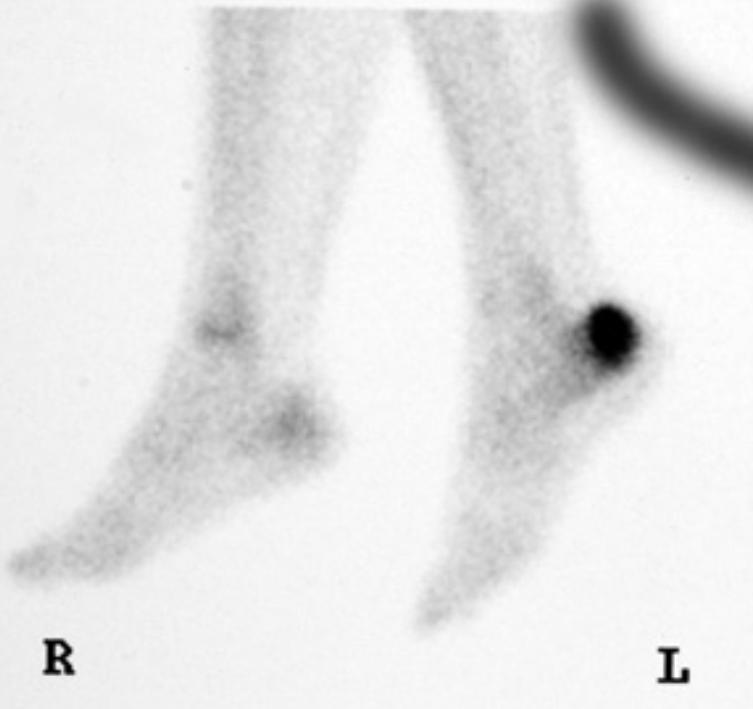
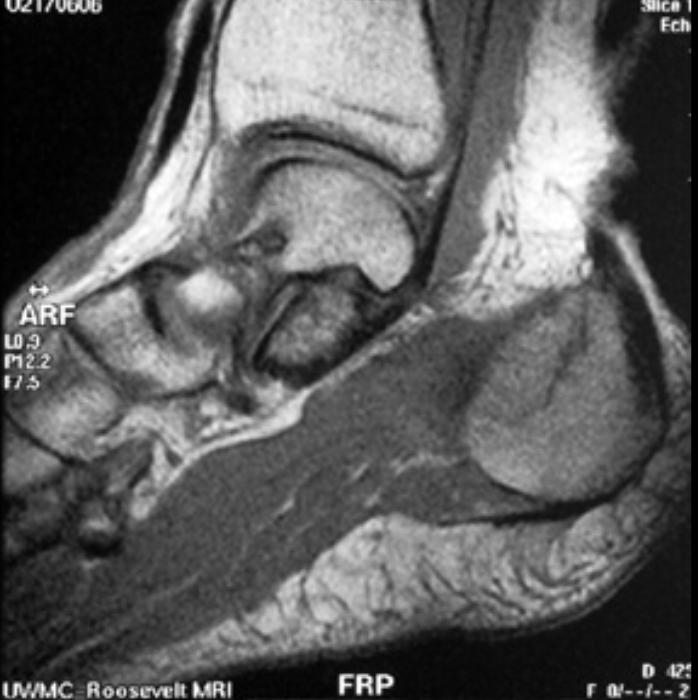
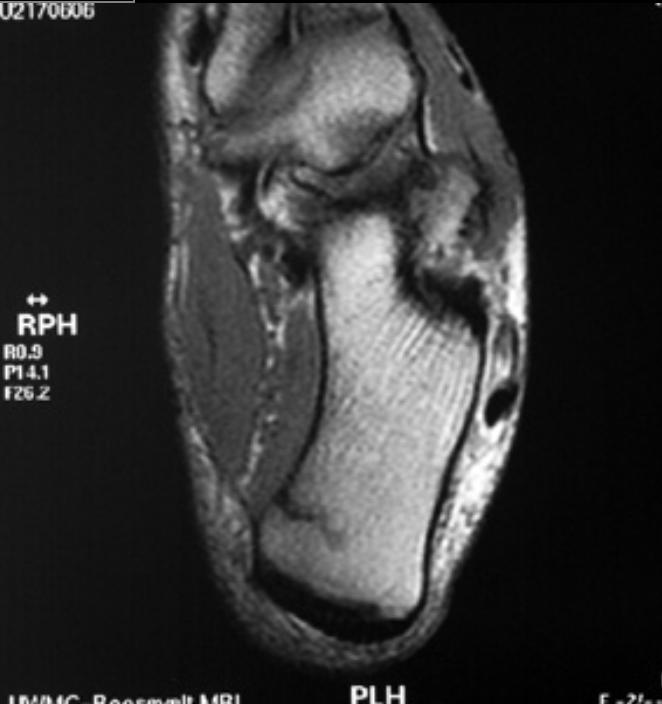
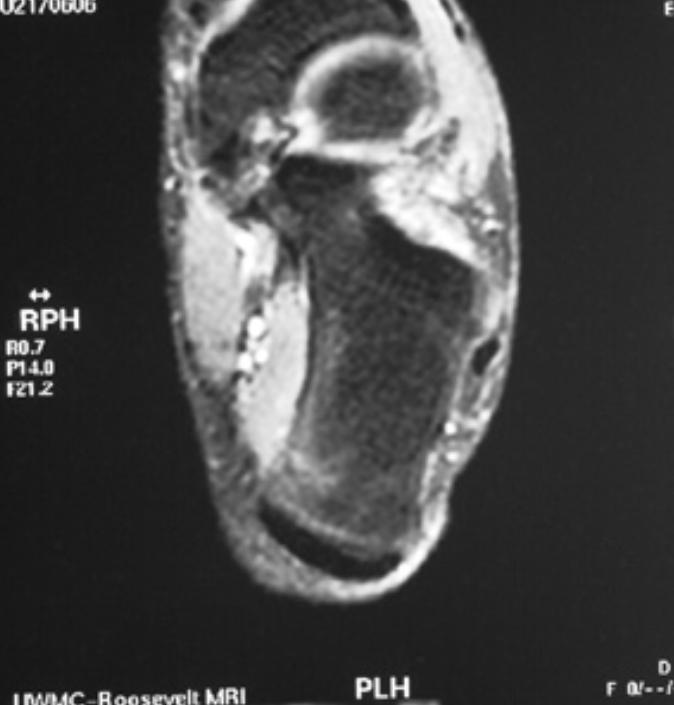
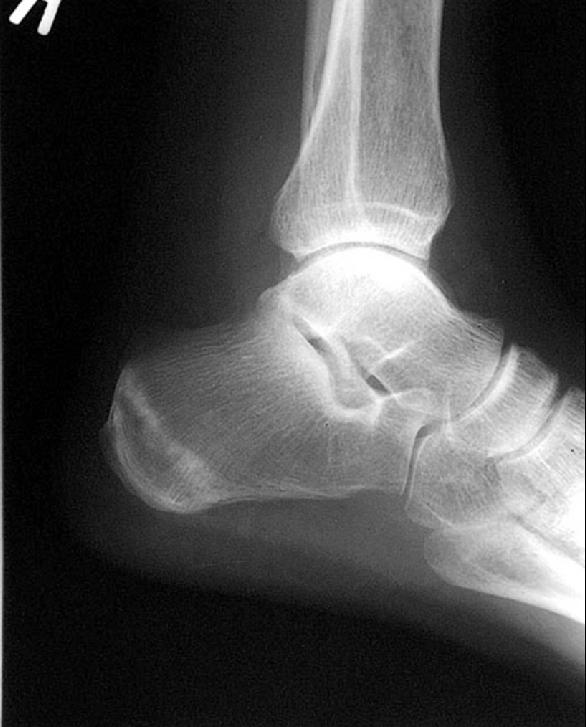
Treatment
If a stress fracture occurs in a weightbearing bone, healing will be delayed or prevented by continuing to put weight on that limb.
Rest is the only way to completely heal a stress fracture. The average time of complete rest from the activity that caused the stress fracture is three weeks. A fracture requires 4 to 8 weeks of recuperation, however, which may include no more than light use of the injured body part, as long as activity does not cause pain. After the recuperative period, another 2 weeks of mild activity without any pain may be recommended before the bone may be safely considered healed and activity may gradually increase.
During this time, it is advised that training errors be identified (for instance, too much, too soon) and avoided in the future. One rule of thumb is to not increase the volume of training by more than 10% from one week to the next.
Rehabilitation usually consists of muscle strength training to help dissipate the excessive forces transmitted to the bones.
Applying ice on the affected area where the stress fracture occurs for three minutes or more is a good way to treat it.
In some cases, an electronic stimulator or bone stimulator may be used. These devices send electrical impulses into the bone to promote healing; recent studies have shown that the bone heals naturally via electromagnetic stimulation.
Electromagnetically stimulating the bone causes the bone to lay out more bone cells that strengthen the bone.
Bracing or casting the limb with a hard plastic boot or air cast may also prove beneficial by taking some stress off the stress fracture. An air cast has pre-inflated cells that put light pressure on the bone, which promotes healing by increasing blood flow to the area and takes away a lot of the pain because of the pressure it applies to the bone. If the stress fracture is severe enough, crutches also help to take all stress off the bone.
With severe stress fractures, surgery may be needed for proper healing. The procedure may involve pinning the fracture site, and rehabilitation can take up to a half year.[4]
Causes
Bones are constantly attempting to remodel and repair themselves, especially during a sport where extraordinary stress is applied to the bone. Over time, if enough stress is placed on the bone that it exhausts the capacity of the bone to remodel, a weakened site -- a stress fracture -- on the bone may appear. The fracture does not appear suddenly. It occurs from repeated traumas, none of which is sufficient to cause a sudden break, but which, when added together, overwhelm the osteoblasts that remodel the bone.
Stress fractures commonly occur in sedentary people who suddenly undertake a burst of exercise (whose bones are not used to the task). They may also occur in Olympic-class athletes who do extraordinary quantities of high-impact exercise, or in soldiers who march long distances.
Muscle fatigue can also play a role in the occurrence of stress fractures. For every mile a runner runs, more than 110 tons of force must be absorbed by the legs. Bones are not made to stand that much energy on their own and the muscles act as shock absorbers for the excess force. But, as muscles become tired and stop absorbing most of the shock, the bones experience greater amounts of stress. Finally, when muscles (usually in the lower leg) become so fatigued that they stop absorbing any shock, all forces are transferred to the bones.
Previous stress fractures have been identified as a risk factor.[5]
Frequency
Dr. Johnathan C Reeser states that, in the US, the annual incidence of stress fractures range from 5% to 30%, depending on the sport and other risk factors.[6] Stress fractures occur less frequently in those of black African descent than in Caucasians, due to a higher BMD (bone mineral density) in the former. Women and highly active individuals are also at a higher risk. The incidence probably also increases with age due to age-related reductions in BMD. But children may also be at risk because their bones have yet to reach full density and strength. The female athlete triad also can put women at risk, as disordered eating and osteoporosis can cause the bones to be severely weakened.
Prevention
One method of avoiding stress fractures is by adding more stress to the bones. Although counter-intuitive given that stress fractures are caused by too much stress on the bones, when moderate stress is applied to the bone in a controlled manner, the bone becomes stronger and less susceptible to a stress fracture. An easy way to do this is to follow one widely known rule for runners, which states that mileage should be increased by no more than 10% per week. This allows the bones to adapt to the added stress so they are able to withstand greater amounts of stress in the future.
Strengthening exercises also help build more muscle strength in the legs. Strengthening these muscles will stop them from getting fatigued so quickly, which allows them to absorb the pounding of running for longer periods of time. Key muscles that need to be strengthened with lower leg stress fractures are the calves and the shin muscles.
Depending on a variety of factors including weight, running surface and shoe durability, runners should replace their shoes every 300-700 miles to allow adequate mid-sole cushioning. A change in the choice of running surfaces can also help prevent stress fractures. However, it is also argued that cushioning in shoes actually causes more stress by reducing the body's natural shock absorbing action, increasing the frequency of running injuries.[7]
When performing any exercise that applies more stress to the bones, it may be wise to increase calcium and vitamin D intake, depending on the individual. Also, it is important to monitor foods eaten because nutrition plays a vital role in bone development. Certain individuals are at risk of osteoporosis, and depending on the country in which medical care is being supplied, there may be a screening program in place.
A new study released by Creighton University has shown Calcium and Vitamin D supplementation, even over a short time period, can significantly reduce stress fractures (overuse injuries to the bone) in female military recruits, according to a study reported Sunday, Feb. 11, 2007 at the 53rd annual Orthopaedic Research Society meeting at the San Diego Convention Center.[8]
References
- ↑ Template:Dorlands
- ↑ "Stress fractures - MayoClinic.com". Retrieved 2007-12-23.
- ↑ "Common Stress Fractures - October 15, 2003 - American Family Physician". Retrieved 2007-12-23.
- ↑ "Stress fractures - CNN.com". Retrieved 2007-12-23.
- ↑ Kelsey JL, Bachrach LK, Procter-Gray E; et al. (2007). "Risk factors for stress fracture among young female cross-country runners". Med Sci Sports Exerc. 39 (9): 1457–63. doi:10.1249/mss.0b013e318074e54b. PMID 17805074.
- ↑ "eMedicine - Stress Fracture : Article by Jonathan C Reeser, MD, PhD". Retrieved 2007-12-23.
- ↑ "Is Barefoot Better? Some Athletes Say Running Shoeless Benefits Body and Sole". Retrieved 2007-12-02.
- ↑ "Calcium and Vitamin D significantly reduce stress fractures". Retrieved 2007-02-20.
Template:Diseases of the musculoskeletal system and connective tissue Template:SIB